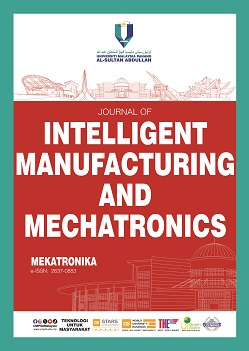Advancing Security Measures: A Brainwave-Based Biometric System for User Identification and Authentication
DOI:
https://doi.org/10.15282/mekatronika.v6i1.10185Keywords:
Biometric Authentication System, Electroencephalogram, EEG Theta Band, EEG Alpha Band, EEG Beta Band, Classification AccuracyAbstract
In contemporary organizational contexts, the imperative for robust user identification and authentication systems to safeguard assets is paramount. Conventional methods like passwords, secret codes, and personal identification numbers are prone to compromise and human error. This study explores the feasibility of utilizing human brainwaves, specifically Electroencephalogram (EEG) signals, as a biometric authentication system. Employing the Unicorn Hybrid Black EEG device for measurement and LabVIEW software for analysis, the research focuses on discerning EEG features pertinent to authentication. Through controlled activities encompassing imaginative (imagining singing a favorite song, imagining opening a locked door) and physical tasks (engaging in a mobile game, solving a Rubik's cube), the study elucidates the dominance of the EEG Theta band across varied cognitive and motor processes. Further analysis underscores the heightened power of the EEG Alpha band during relaxation phases and the prevalence of the EEG Beta band during heightened cognitive engagement. The classification of selected EEG features highlights the efficacy of utilizing Standard Deviation as a discriminative factor, achieving a commendable accuracy of 93.35% with a training-testing ratio of 80:20. This research underscores the potential of EEG-based authentication systems in fortifying organizational security protocols.
References
Thomas KP, Vinod AP. EEG-Based Biometric Authentication Using Gamma Band Power During Rest State. Circuits Syst Signal Process. 2018 Jan;37(1):277–89.
Guzel Aydin S, Kaya T, Guler H. Wavelet-based study of valence–arousal model of emotions on EEG signals with LabVIEW. Brain Inf. 2016 Jun;3(2):109–17.
Sahu S, Sharma A. Detecting brainwaves to evaluate mental health using LabVIEW and applications. In: 2016 International Conference on Emerging Technological Trends (ICETT) [Internet]. Kollam, India: IEEE; 2016. p. 1–4. Available from: http://ieeexplore.ieee.org/document/7873738/.
Jalaly Bidgoly A, Jalaly Bidgoly H, Arezoumand Z. A survey on methods and challenges in EEG based authentication. Computers & Security. 2020 Jun;93:101788.
Al-Qazzaz NK, Ali SHBMd, Ahmad SA, Chellappan K, Islam MdS, Escudero J. Role of EEG as Biomarker in the Early Detection and Classification of Dementia. The Scientific World Journal. 2014;2014:1–16.
Thomas KP, Vinod AP. EEG-Based Biometric Authentication Using Gamma Band Power During Rest State. Circuits Syst Signal Process. 2018 Jan;37(1):277–89.
Thomas KP, Vinod AP, Robinson N. Online Biometric Authentication Using Subject-Specific Band Power features of EEG. In: Proceedings of the 2017 International Conference on Cryptography, Security and Privacy [Internet]. Wuhan China: ACM; 2017. p. 136–41. Available from: https://dl.acm.org/doi/10.1145/3058060.3058068.
Ma L, Minett JW, Blu T, Wang WSY. Resting State EEG-based biometrics for individual identification using convolutional neural networks. In: 2015 37th Annual International Conference of the IEEE Engineering in Medicine and Biology Society (EMBC) [Internet]. Milan: IEEE; 2015 [cited 2024 Apr 22]. p. 2848–51. Available from: https://ieeexplore.ieee.org/document/7318985/.
Harshit, Smitha KG, Thomas KP, Vinod AP. Online Electroencephalogram (EEG) based biometric authentication using visual and audio stimuli. In: 2016 IEEE EMBS Conference on Biomedical Engineering and Sciences (IECBES) [Internet]. Kuala Lumpur, Malaysia: IEEE; 2016 [cited 2024 Apr 22]. p. 454–9. Available from: https://ieeexplore.ieee.org/document/7843492/.
Abdulkader SN, Atia A, Mostafa MSM. Brain computer interfacing: Applications and challenges. Egyptian Informatics Journal. 2015 Jul;16(2):213–30.
Hasan MM, Hossain MM, Sulaiman N. Fatigue State Detection Through Multiple Machine Learning Classifiers Using EEG Signal. Applications of Modelling and Simulation. 2023;7:178–89.
Hasan MM, Hossain MM, Sulaiman N, Khandaker S. Microsleep Predicting Comparison Between LSTM and ANN Based on the Analysis of Time Series EEG Signal. JTEC. 2024 Mar 31;16(1):25–31.
UNICORN HYBRID BLACK [Internet]. [cited 2024 Mar 26]. Available from: https://www.gtec.at/product/unicorn-hybrid-black/
Sulaiman N, Taib MN, Lias S, Murat ZH, Aris SAM, Hamid NHA. EEG-based Stress Features Using Spectral Centroids Technique and k-Nearest Neighbor Classifier. In: 2011 UkSim 13th International Conference on Computer Modelling and Simulation [Internet]. Cambridge, United Kingdom: IEEE; 2011. p. 69–74. Available from: http://ieeexplore.ieee.org/document/5754189/.
Dornhege G, Millán J del R, Hinterberger T, McFarland DJ, Müller KR. Toward Brain-Computer Interfacing. Vol. 167. MIT Press; 2007.
Sulaiman N, Goh KS, Rashid M, Jadin S, Mustafa M, Ibrahim MZ, et al. Offline LabVIEW-Based EEG Signals Analysis to Detect Vehicle Driver Microsleep. In: Hassan MHA, Che Muhamed AM, Mohd Ali NF, Lian DKC, Yee KL, Safii NS, et al., editors. Enhancing Health and Sports Performance by Design [Internet]. Singapore: Springer Singapore; 2020. p. 271–89. (Lecture Notes in Bioengineering). Available from: http://link.springer.com/10.1007/978-981-15-3270-2_29.
Isa RM, Pasya I, Taib MN, Jahidin AH, Omar WRW, Fuad N, et al. EEG brainwave behaviour due to RF Exposure using kNN classification. In: 2013 IEEE 3rd International Conference on System Engineering and Technology [Internet]. Shah Alam, Malaysia: IEEE; 2013 [cited 2024 Apr 22]. p. 385–8. Available from: http://ieeexplore.ieee.org/document/6650205/.
Mehmood RM, Lee HJ. Emotion classification of EEG brain signal using SVM and KNN. In: 2015 IEEE International Conference on Multimedia & Expo Workshops (ICMEW) [Internet]. Turin, Italy: IEEE; 2015. p. 1–5. Available from: https://ieeexplore.ieee.org/document/7169786.
Armstrong BC, Ruiz-Blondet MV, Khalifian N, Kurtz KJ, Jin Z, Laszlo S. Brainprint: Assessing the uniqueness, collectability, and permanence of a novel method for ERP biometrics. Neurocomputing. 2015 Oct;166:59–67.
Downloads
Published
Issue
Section
License
Copyright (c) 2024 The Author(s)

This work is licensed under a Creative Commons Attribution-NonCommercial 4.0 International License.




